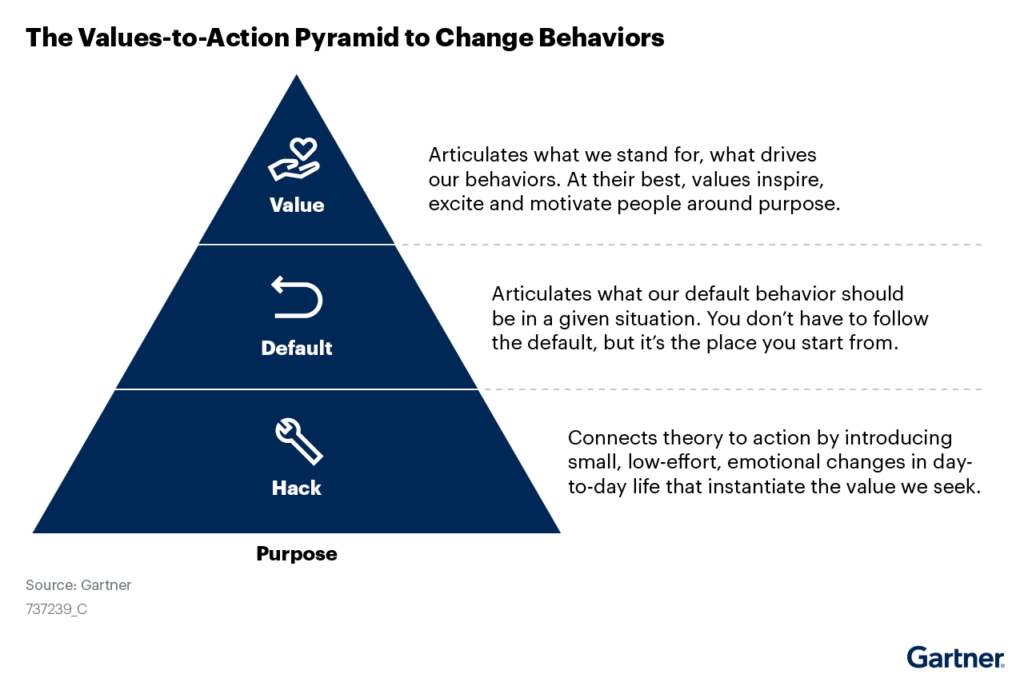
Seven out of 10 boards of directors say they are responding to the COVID-19 crisis by accelerating digital business initiatives, according to Gartner’s 2021 View from the Board of Directors Survey.
Accelerating digital business means working differently and faster, but people don’t change working habits on command. It takes a deliberate process to insert culture change into employees’ daily lives.
Executive leaders must frame the change for employees by defining new values or doubling down on existing ones, and then linking expected behaviours to them.

For example, if we aim to accelerate digital business, we likely need to promote agility as a critical value. People can enact this value through default behaviours, such as making decisions more quickly. This doesn’t make quick decisions a hard-and-fast rule; people can still choose a different behaviour when the situation calls for it, but they should default to faster decisions in the absence of any other factors.
That’s still not enough to get actual habits to change. To do that, we can jump-start the adoption of these behaviours by deploying certain culture hacks. In fact, Gartner recommends that leaders focus on three default behaviours to make the organisation more agile (and we offer culture hacks for each of them):
- Speed up decision making
- Simplify work
- Eliminate unnecessary tasks
Speed up decision making
The keys to accelerated product delivery, governance, and other processes come from enabling faster decision making within the organisation. The reasons that decisions often take too much time vary: responsibility avoidance, risk aversion, unclear goals, ill-defined projected outcomes or lack of information.
The speed of a decision should be determined by the speed with which it can be reversed. That is, the less critical a decision is, the shorter amount of time it should take to make it. Likewise, if the decision is more consequential, the more time it should take to make it.

Hack No. 1: “No” isn’t allowed
Leaders can’t just say “this won’t work.” Instead, they should ask, “How would this work, given XYZ regulations?” Make sure you reframe the negative as a request for more information, especially for any ideas that are new or untested.
Hack No. 2: The buck stops here
Only one person is required to approve any decision that is under $X. Be clear on who that is and when they have the authority to approve the decision.
Hack No. 3: Seek resistance first
Find the person most likely to disagree with your decision and ask them to tell you everything wrong with it. Address the concerns early for faster decision making.
Simplify work
Work routines and processes tend to become more complicated over time to accommodate more “requirements.” We assume that the more complicated the work is, the more value it creates. But this is often false. For example, an analytics team takes extra days to prepare a monthly report because one small department wants a complicated data cut. Meanwhile, the larger departments can’t make decisions while they’re waiting for the report.
Simpler is better in many cases, but oddly, it takes active work to keep things simple. Leaders can simplify work by adopting a zero-based starting point. Look at the tasks that must be done and ask: What is the simplest and fastest way to get the work done? For any routine or process, start with the simplest possible approach even if it is not comprehensive. Complicated does not always — or even often — equal worthy.
Hack No. 4: Limit time
Give a time limit of 24 hours to create a first draft or prototype.
Hack No. 5: Reverse-mentoring hour
Assign senior executives to junior employees for one hour, and have the junior employee show them what can be done to simplify work.
Hack No. 6: Meme city
Turn employees into culture creators. Give an award to the top three “simplify work” memes.

Eliminate unnecessary tasks
Too often, the value of work is measured by the output generated rather than the actual outcome. Focusing on output is really only a way to make people look busy, and busy doesn’t necessarily mean productive. What really matters, of course, is the end result.
To make an organisation more agile, shift the focus to what the business outcome actually is, rather than how the task to achieve it is performed.
Hack No. 7: “Red light, green light”
Like the kids’ traffic cop game, regularly discuss as a team: “What tasks are we doing that should we red light (stop), green light (start) and yellow light (continue)?” The influence of these decisions should be their outcome – is it a tangible result that benefits the business or something that wouldn’t be missed if stopped.
Hack No. 8: Eliminate ideas without a sponsor
Test commitment from business leaders with their commitment to fund your initiative with real money. If it’s not there, stop working on it immediately.
Hack No. 9: Hold a weekly “break the rules” meeting
Hold a weekly special hacking meeting where the team breaks the rules: scratches policies, cancels old procedures, empowers people, provides budget to new ideas, connects people and so on. This hack challenges toxic cultural behaviours, including cynicism and negativity, such as “I can’t” “I don’t have budget” or “I’m not allowed.”
Conclusion
Executive leaders who are guiding digital business transformation during COVID-19 should revisit their enterprise principles and values. Adapt them as necessary to inspire people during the remainder of the COVID-19 pandemic, its aftermath and to address future disruptions.
Assess whether people and partners have internalised the new principles and find them useful. For every value, determine default behaviours and create hacks to insert those behaviours into day-to-day work life. Unless and until you do this, all you have are nice-sounding aspirations.

Mary Mesaglio
Distinguished Research Vice President at Gartner


